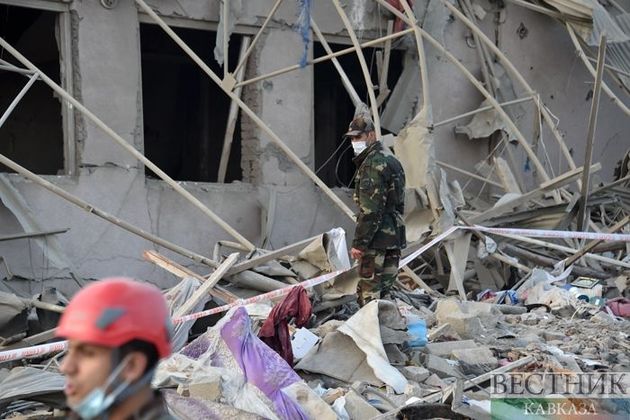Turkey's Ombudsman Institution prepared a report on Armenia's war crimes and human rights violations against Azerbaijan, detailing the atrocities by the Armenian Army in the Nagorno-Karabakh region before its recent liberation, Daily Sabah writes in the article Report reveals Armenian war crimes against Azerbaijan.
Speaking to Anadolu Agency (AA), the head of the institution, Şeref Malkoç, said that from this week on, the report will be sent to all the related institutions both within and outside Turkey, including the European Union and EU countries' parliaments' human rights commissions.
Malkoç, reiterating that one of the main duties of the Ombudsman Institution is to work toward improving and protecting human rights at both the national and international level, expressed that they have visited Azerbaijan and examined the civilian settlements damaged during Armenian attacks.
"During our visit to Azerbaijan, we conducted our inspections in areas particularly outside the war fronts, in civilian settlements such as Ganja, Tartar, Goranboy, Aghdam and even the areas near Baku, which were all hit by Armenian missiles," Malkoç said, adding that in these attacks, a total of 94 Azerbaijani civilians were killed, while 414 others were injured.
"Of course we all wish to not have any war at all. However, according to international law, either in self-defense or for other possible reasons, there might be wars sometimes on the fronts. However, deliberately hitting a civilian settlement area that is outside of the war front by 100-150 kilometers is a crime against humanity. It is against the basic rights that are referred to in the European Convention on Human Rights, as well as the Geneva Convention," Malkoç continued.
Ganja has become one of the most targeted Azerbaijani towns of the most recent conflict. The first Armenian attack on the region took place on Oct. 4, when a missile hit the city and killed one while injuring 30 others. The second attack took place on Oct. 8 during which many residential buildings were damaged, however, no loss of life was incurred. Then, on Oct.10, only a day after Russia brokered a cease-fire between the warring sides, Armenia attacked for the third time. An Armenian Scud missile hit an apartment complex in Ganja, completely destroying it. During this attack, the city's infrastructure was heavily damaged as well. In the attack, 10 civilians were killed and 40 others were injured, including women and children. A total of 95 buildings were damaged, impacting the lives of approximately 205 people. The fourth and final attack took place on Oct.17. After the firing of the Armenian Scud missiles, three massive explosions rocked the city. These attacks were made in densely populated areas.
The attack damaged about 20 buildings and killed 15 civilians. Fifty-five civilians were also injured. The attacks have been strongly condemned by Azerbaijan and Turkey, while Armenia denied targeting civilian settlements in the city. Although countries such as Qatar, Malaysia, Switzerland and the U.K. expressed their condolences over the incident, the majority of the international community has remained mostly silent. Condemnation came from the EU regarding the fourth attack, while the U.N. referred to the incident as "unacceptable."
Expressing that during their visit they had to witness the most brutal outcomes of the war, Malkoç said they conducted interviews with the relatives of the victims of the war.
"We talked with children who lost their parents. We saw the damaged schools, houses. We saw the damage that the sanctuaries had to suffer due to the attacks. We saw how the environment was damaged, and how the forbidden weapons, bombs were used. Our report explains all this," Malkoç highlighted.
Based on seven chapters, the report has titles such as "The problem of Nagorno-Karabakh," "Determinations reached as a result of the physical site visit" and "The evaluation of the conflicts from the perspective of human rights."
"Apart from these, we also made a chronological list of the Armenian attacks within our report. We have inspected the photographs of the civilians who fell victim to Armenian attacks and places that they were killed one by one," Malkoç said.
"By determining the ones who committed war crimes, killed civilians, damaged the environment, killed infants or elderly – who have nothing to do with the war after midnight, we have worked to bring these criminals to the international court to be judged for their crimes," he added, indicating that they have completed their part, and now it is time for the international institutions to do whatever it takes to get justice for the victims.
Pointing out that Armenia assumes it will get away with its war crimes without taking any responsibility, Malkoç said: "There is one thing that they forgot. The world is no longer the same as it was before. Azerbaijan is no longer same Azerbaijan as before. Turkey is no longer same Turkey as before. So, they assume the ones who have spoiled them so far will continue to protect them. However, this report will be used as evidence in the international courts, while Armenia will be judged for its human rights violations."
"They have committed crimes against the history in Shusha, Aghdam, Tartar and Kalbajar. They turned the mosques into pig barns. They damaged the cemeteries of the Muslims. How can this be possible? The massacres such as Khojaly, as well as these crimes, will be judged so that no one would dare to act the same way ever again," he expressed.
The report expressed that the Armenian Army not only attacked civilian settlements but also used bombs such as cluster munitions that kill without discriminating between innocents and foes, which is why the weapons have been deemed illegal by international law.
Previously, Hikmet Hajiyev, the assistant to the Azerbaijani President Ilham Aliyev, said on Twitter that the Armenian forces targeted Azerbaijani civilians with white phosphorus missiles.
The report contains pictures of civilian settlements and states that include a total of 3,410 houses, 120 apartments and 512 civilian facilities heavily damaged during the attacks.






